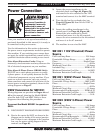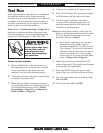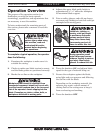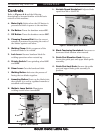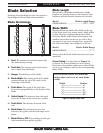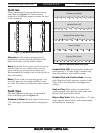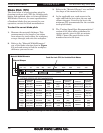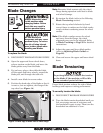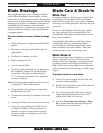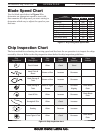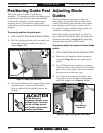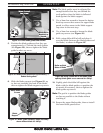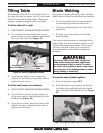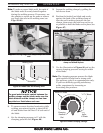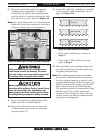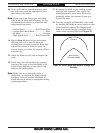
-24-
For Machines Mfg. Since 8/09
Model SB1021/SB1022
OPERATION
Blade Breakage Blade Care & Break-In
Many conditions may cause a bandsaw blade to
break. Blade breakage is unavoidable, in some
cases, since it is the natural result of the peculiar
stresses that bandsaw blades must endure. Blade
breakage is also due to avoidable circumstances.
Avoidable blade breakage is most often the
result of poor care or judgment on the part of the
operator when mounting or adjusting the blade
or support guides.
The most common causes of blade breakage
are:
s Faulty alignment or adjustment of the blade
guides.
s Forcing or twisting a wide blade around a
tight radius.
s Feeding the workpiece too fast.
s Dull or damaged teeth.
s Over-tensioned blade.
s Top blade guide assembly set too high above
the workpiece. Adjust the top blade guide
assembly so that there is approximately
1
⁄8"–
1
⁄4" between the bottom of the assembly
and the workpiece.
Note: The blade guide assembly can be lowered
to within 2
1
⁄2" of the table surface.
s Using a blade with a lumpy or improperly
finished braze or weld.
s Continuously running the bandsaw when not
in use.
s Leaving the blade tensioned when not in use.
s Using the wrong blade pitch (TPI) for the
workpiece thickness. The general rule of
thumb is to have no fewer than two teeth
in contact with the workpiece at all times
during cutting.
Blade Care
A bandsaw blade is a delicate piece of steel that
is subjected to tremendous strain. A bandsaw
blade will last longer if you give it fair treatment
and always use the appropriate feed rate for your
operation.
Be sure to select blades with the proper width,
set, type, and pitch for each application. The
wrong blade will produce unnecessary heat and
have a shortened life.
A clean blade will perform much better than
a dirty blade. Dirty or gummed up blades
pass through the cutting material with much
more resistance than clean blades. This extra
resistance also causes unnecessary heat.
Blade Break-In
The tips and edges of a new blade are extremely
sharp. Cutting at too fast of a feed rate can
fracture these tips and edges, causing the blade
to quickly become dull. Properly breaking-in a
blade allows these sharp edges to wear properly
without fracturing, thus keeping the blade sharp
longer.
To properly break-in a new blade:
1. Choose the correct speed for the blade and
material of the operation.
2. Reduce the feed pressure by half for the first
50–100 in
2
of material cut.
3. To avoid twisting the blade when cutting,
adjust the feed pressure when the total
width of the blade is in the cut.
4. Use the Chip Inspection Chart on Page
25 to ensure that the optimal blade speed
and feed rate are being used.



